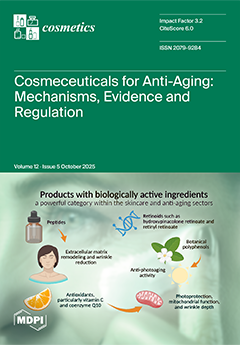Background: Contemporary dermatology and cosmetology continue to explore effective strategies for normalizing the function of oily skin, where excessive sebum production and impairment of the hydrolipid barrier pose considerable therapeutic challenges. The aim of the present study was to evaluate the effects of a series of microneedling mesotherapy treatments with a sebum-regulating ampoule on selected biophysical parameters of the skin in individuals with oily skin.
Methods: The study included 19 female volunteers aged 18–42 years, who underwent six treatment sessions at three-week intervals. Skin parameters were assessed at baseline, after three sessions, and after six sessions using the MPA system (Courage & Khazaka) equipped with the following probes: Corneometer (hydration), Sebumeter (sebum secretion), pH meter (surface pH), Glossymeter (skin shininess), and Tewameter (transepidermal water loss).
Results: After six sessions, hydration significantly increased both in the T-zone (from 43.9 ± 8.0 to 54.0 ± 5.4 AU; +23%) and on the cheeks (from 35.9 ± 8.3 to 55.6 ± 4.8 AU; +55%) (
p < 0.001). Sebum secretion decreased markedly, with values in the T-zone falling from 192.2 ± 30.6 to 127.7 ± 27.2 AU (−34%) and on the cheeks from 185.0 ± 36.2 to 114.8 ± 30.1 AU (−38%) (
p < 0.001). Skin surface pH showed minor but significant modulation within the physiological range (T-zone: 6.33 ± 0.64 → 6.01 ± 0.17; cheeks: 6.14 ± 0.50 → 6.03 ± 0.17;
p = 0.021). TEWL demonstrated a nonsignificant change (T-zone: 17.46 ± 11.31 → 19.09 ± 3.54 g/m
2/h; cheeks: 20.89 ± 5.36 → 18.37 ± 2.95 g/m
2/h;
p > 0.05), while skin gloss remained stable (T-zone: 5.46 ± 1.25 → 5.60 ± 1.16 GU; cheeks: 5.29 ± 1.76 → 4.87 ± 1.20 GU;
p > 0.05).
Conclusions: Microneedling mesotherapy combined with a sebum-regulating ampoule significantly improved skin hydration and reduced sebum secretion, accompanied by stabilization of skin surface pH. Although changes in TEWL and gloss were not statistically significant, the overall results indicate improved skin condition and balance. Despite the absence of a control group, these findings support the potential of this combined approach as an adjunctive therapy for oily skin. Further controlled studies with larger cohorts are warranted to confirm its efficacy and long-term effects.
Full article





